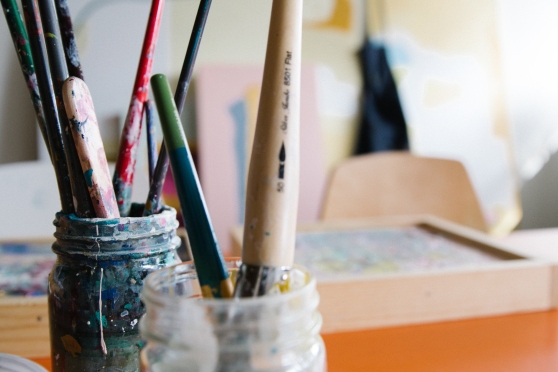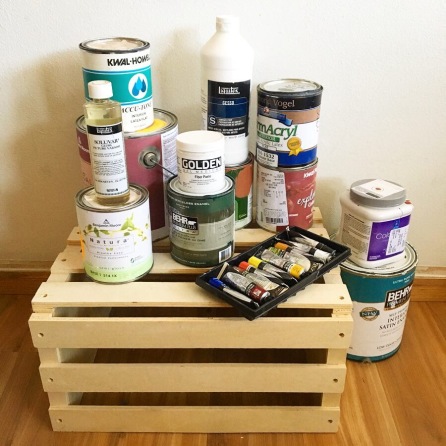What do you do when you’re done painting and want to clean your brushes? Do you wash your brushes under a running faucet? Do you ever think about where the chemicals from your paint end up? Does a magic fairy poof them out of our water supply at the local water treatment center? Maybe. But Probably not.
If you’re like me, and are an artist, but are also deeply concerned about reducing your negative environmental footprint, you’ve probably had some of the above thoughts while you try to clean up after painting. I’ve tried to collect a few tips for how to keep my art practice as non-toxic and as ‘zero-waste’ as possible. This is not an official or a complete list of must-do’s, but more of a starting point that hopefully inspires more research and more effort from the art community to start looking for ways to make art more eco-friendly.

Here are a few steps you can take to start shifting your art practice into a more sustainable one…
- What type of paint are you using?Oil paints should NEVER be washed down the sink. I don’t think this one needs much explanation- oil + water= X. Acrylic paints are a bit more complicated. I will include latex-based paints in this category as well, because they can be treated relatively similarly when it comes to disposal. Acrylic and latex-based paints are generally considered to be non-toxic, as they are ‘water-based’ … but does this mean they are safe to dump into our water supply? Generally speaking, no they are not. Although acrylic and latex paints are understood to be less toxic than oil paints, they do not belong in our water.
Acrylic and latex paints often contain highly toxic chemicals such as surfactants (which essentially disperse the pigments within a paint tube), emulsifiers, biocides, anti-foaming agents and any number of additives. Many water treatment facilities cannot remove these from a water supply and prohibit pouring any such things into the water to begin with. - Being mindful while you work.
One habit that I have adopted over the last year or so is being more mindful while I am painting, and throughout my entire creative process. This includes thinking about where I purchase my supplies, shopping locally for everything that I can or looking at secondhand stores. It includes starting to make many of my own materials. It includes everything down to my painting techniques. I keep some extra, unstretched canvas nearby while I work, so that I can work off extra paint on my brush onto a canvas that will eventually become a painting (This obviously lends itself a little more to abstracts).
I also think long and hard before I squeeze out a large helping of paint onto my palette. I do my very best never to leave any unused paint on my palette. I water down my colors to make them go further and to achieve the color I’m looking for. I use my palette knife to squeeze out any excess paint that might be hiding in the bristles of my brush.
As I have started incorporating more mindfulness into my creative process, I have begun to notice how many materials I save, how my actual pieces have evolved… and it teaches me how to be in the habit of being resourceful in other areas of my life as well. - Being prepared for clean-up, before starting to clean up.
For me, this means having the necessary tools ready and handy so that I can be done with my clean up in a minimal amount of time. I have found that I can reuse the same water for a couple of days if I add a small amount of soap to each water jar when I fill it. I keep probably a dozen or so different jars, which maybe is not ideal if you are tight on space. The different jars are designated for different colors – I have a jar for whites/light tans, light warms , dark warms, light cools, dark cools. If you don’t have the space for that, you can try having a light and a dark jar. - Paint is easier to discard in solid form, instead of liquid.If it’s time to clean out these jars, I first let them sit for about 24 hours. This gives the paint enough time to settle at the bottom of the jar, so that I can pour out a large portion of the water without all of the chemicals going with it. Setting the jars in the sun or simply setting them aside for another 24 or so hours will allow the paint ‘plate’ that has formed at the bottom of the jar to solidify and dry out (sprinkling some cat litter can also speed up this process). You can then remove this plate using a brush or a knife or your finger and discard of it in your trash.
- Making your own paint.
This is a topic which I, unfortunately, have no experience with. But I intend to explore this in the future and will be able to offer advice soon. For now, I encourage you to explore different options that might be available to you, locally (and to share this knowledge!) or to look for eco-friendly paint manufacturers or paint-alternatives (sustainably sourced dyes, natural foraged pigments, etc.)
While this is not an entirely zero-waste practice, at the moment, I hope that this can offer some insight into looking at your creative process a little bit differently, and hopefully inspire you to look for more ways to convert the art world into a more sustainable practice.
Light and love!
E
PS- If you’re looking to research this topic further, feel free to check out these other sites, where I also have received helpful info to write this article!
Is it really OK to pour paint down the drain?
https://www.thoughtco.com/ingredients-in-acrylic-paint-3976990
https://opusartsupplies.com/how/product-qa/acrylics-best-practices
All images by E. Wendt
Elaine Wendt © All rights reserved. 2019.
